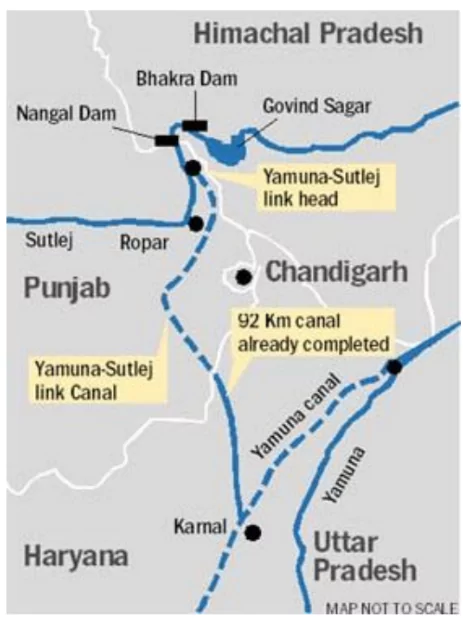Recently, all parties in Punjab came together to reject the Bhakra Beas Management Boards’s (BBMB’s) decision to release an extra 4,500 cusecs of water to Haryana, escalating tensions with Haryana over water sharing.
Background of the Dispute
- Historical Context: The origins of the dispute date back to the reorganization of Punjab in 1966, which led to the creation of Haryana.
 This triggered the issue of equitable sharing of river waters, particularly the Ravi, Beas, and Sutlej rivers.
This triggered the issue of equitable sharing of river waters, particularly the Ravi, Beas, and Sutlej rivers.
- Sutlej-Yamuna Link (SYL) Canal:
- Conceptualized to divert water from Ravi and Beas to Haryana.
- Out of 214 km, 92 km is in Haryana (completed); 122 km in Punjab (remains incomplete due to political opposition and threats from militants).
- The Supreme Court has repeatedly directed Punjab to complete the canal, but progress is stalled.
- Legal and Institutional Framework
- Indus Waters Treaty (1960): India retained Ravi, Beas, and Sutlej.
- 1966 Reorganization Act: formed new state Haryana and Created BBMB (Bhakra Beas Management Board) to manage shared projects.
- 1981 & 1985 Agreements: Adjusted shares among Punjab, Haryana, Rajasthan; reaffirmed by the Punjab Accord.
- Eradi Tribunal (1987): Recommended 5 MAF (Million Acre-Feet) for Punjab, 3.83 MAF for Haryana.
- Punjab Termination of Agreements Act (2004): Unilaterally annulled past agreements; declared unconstitutional by the Supreme Court.
- Current Flashpoint
- Controversial Order: Recently, the Bhakra Beas Management Board (BBMB) ordered the release of 8,500 cusecs of water to Haryana.
- Currently, it receives 4,000 cusecs daily.
- Haryana’s Demand: The row started after Haryana sought 8,500 cusecs of water from Bhakra Dam.
- Conflict: Punjab CM refused, stating Punjab has no water to spare.
Reasons for the Water Crisis in Punjab and Haryana
- Declining Snowfall and River Inflows: Dams like Bhakra, Pong, and Ranjit Sagar have recorded 12–32 feet lower water levels in 2025 compared to the previous year.
- Erratic Monsoons and Rainfall Deficit: Irregular monsoons have reduced the annual replenishment of rivers and groundwater aquifers.
- Water-Intensive Cropping Patterns: Punjab and Haryana grow paddy and wheat extensively, both highly water-consuming crops.
- Groundwater Overexploitation: Punjab meets 47% of its water demand through groundwater; over 79% of its land area is classified as over-exploited.
- In Haryana, southern districts like Hisar, Sirsa, and Fatehabad face groundwater depletion of up to 1700 feet.
- Incomplete Sutlej–Yamuna Link (SYL) Canal: Haryana lacks direct access to Ravi-Beas water due to the non-completion of SYL.
- Poor River and Flood Water Management: Punjab fails to capture and utilise excess monsoon water, much of which flows into Pakistan.
- Increasing Population and Demand: Rising population in both states increases demand for drinking, domestic, and industrial water, further straining supply.
- Lack of Real-Time Monitoring & Basin-Level Planning: Absence of real-time data sharing and forecasting hampers coordination during critical depletion periods.
|
About Interstate Water Disputes
- An Interstate River Water Dispute refers to a conflict or disagreement between two or more states in India over the use, distribution, or control of water from a river or river valley that flows across state boundaries.
Causes of Interstate Water Disputes
- Unequal River Geography and Flow: Rivers often originate in one state and flow through others, causing conflicts over source vs. downstream access (e.g., Punjab vs. Haryana over Ravi-Beas).
- Upstream states control flow, while downstream states claim historical rights.
- Ambiguous and Outdated Agreements: Many water-sharing agreements (like 1955 or 1981 Ravi–Beas allocations) were made without scientific data or long-term planning.
- These become contested when water demand or availability changes.
- Climate Change and Ecological Stress: Declining snowfall, erratic rainfall, and dam inflows reduce available water (e.g., Bhakra and Pong dam levels fell sharply in 2025).
- Depleting aquifers and drying rivers heighten competition for scarce resources.
- Environmental flow requirements to maintain river ecosystems further complicate allocations.
- Agricultural Dependence and Overuse: States like Punjab and Haryana grow water-intensive crops like paddy and sugarcane.
- Over-extraction of groundwater and inefficient irrigation exacerbate shortages.
- Incomplete Infrastructure: Projects like the Sutlej–Yamuna Link (SYL) Canal remain unfinished due to political opposition and legal hurdles.
- This hinders equitable distribution despite tribunal awards.
- Political Polarisation and Federal Tensions: Water becomes a tool for electoral mobilization, making disputes harder to resolve.
- States often defy tribunal and Supreme Court directives (e.g., Punjab’s 2004 Termination Act).
- Institutional Deficits and Data Gaps: Lack of real-time water data, weak basin authorities, and unfilled posts in bodies like BBMB lead to mistrust and administrative breakdown.
- Tribunals are slow and lack multidisciplinary expertise.
Impacts of Inter-State Water Disputes
- Agricultural Distress: Delayed irrigation affects cropping cycles, productivity, and farmer incomes.
- Haryana’s failure to access Ravi–Beas waters due to the incomplete SYL Canal leads to over 3 lakh hectares lying uncultivated in drought-prone districts.
- Strained Federal Relations: Disputes erode cooperative federalism and lead to confrontation between states and the Centre.
- Example: Punjab’s refusal to implement SC orders on SYL and the 2004 law annulling water-sharing agreements illustrates constitutional defiance.
- Legal and Institutional Gridlock: Tribunals take years or even decades to deliver verdicts.
- Even after verdicts, implementation is weak, as states often refuse compliance (e.g., Karnataka in Cauvery case; Punjab in SYL).
- Urban and Drinking Water Crisis: Prolonged disputes disrupt urban water planning, especially in fast-growing cities.
- Example: Cities like Hisar, Sirsa, and Fatehabad in Haryana face acute drinking water shortages due to unresolved BBMB allocations.
- Economic Underdevelopment: Lack of assured irrigation water and industrial supply deters investment and affects agricultural export zones.
- Example: Haryana’s agrarian economy in southern districts is affected due to lack of canal water access.
- Ecological Damage: States over-exploit groundwater and ignore environmental sustainability during disputes.
- Punjab draws 47% of its water from aquifers, leading to 79% of the state being water-stressed.
- Social and Political Unrest: Water becomes an emotive issue, fuelling mass protests, regionalism, and political polarisation.
- In Punjab, SYL Canal protests in the 1990s led to militant attacks on engineers and remain politically sensitive today.
- International Implications: Poor coordination leads to unutilised water flowing into Pakistan, especially from Punjab via the Ravi and Beas during monsoons.
- Weak domestic water governance complicates transboundary diplomacy under treaties like the Indus Waters Treaty.
Constitutional and Legal Framework
- Constitutional Provisions
- Article 262: Empowers Parliament to:
- (1) Provide for adjudication of disputes relating to inter-State rivers.
- (2) Bar the jurisdiction of the Supreme Court or any other court in such matters if Parliament so provides.
- Seventh Schedule
- Entry 17, State List: States can legislate on water, irrigation, etc.
- Entry 56, Union List: Centre can regulate inter-State rivers if Parliament declares it in public interest.
Key Legislations
- Inter-State Water Disputes Act, 1956: Enables formation of ad hoc tribunals for specific disputes.
- Tribunal decisions are final and binding.
- Courts (including SC) have no jurisdiction once a matter is referred to a tribunal.
- River Boards Act, 1956: Provides for inter-governmental River Boards for basin-level management.
- Never effectively implemented: No River Board has been created under this Act.
- Inter-State River Water Disputes (Amendment) Bill, 2019: Proposes a permanent tribunal with multiple benches.
- Fixes timelines: 2 years for decision + 1-year extension.
- Includes data bank and information system for each basin.
Major Inter-State River Disputes
| River |
States Involved |
Present Status |
| Cauvery |
Karnataka, Tamil Nadu, Kerala, Puducherry |
CWMA (Cauvery Water Management Authority) and CWRC (Cauvery Water Regulation Committee) operational under SC |
| Krishna |
Maharashtra, Karnataka, Telangana, Andhra |
Krishna Water Dispute Tribunal-II; matter sub-judice |
| Ravi–Beas (SYL Canal) |
Punjab, Haryana |
Incomplete SYL; matter in SC |
| Mahanadi |
Chhattisgarh, Odisha |
Tribunal set up in 2018 |
| Godavari |
Maharashtra, Telangana, Andhra |
Resolved in 1980 |
| Mahadayi |
Goa, Karnataka, Maharashtra |
Tribunal awarded; dispute continues |
Way Forward for Interstate River Water Disputes
- Establish a Permanent Water Dispute Tribunal: Expedite passage and implementation of the Inter-State River Water Disputes (Amendment) Bill, 2019.
- A permanent tribunal with multiple expert benches will ensure time-bound resolution (within 2–3 years).
- Strengthen River Basin Authorities: Create River Basin Management Authorities with representation from all riparian states.
- Facilitate scientific water-sharing plans, promote data transparency, and enable collaborative decision-making.
- Complete Critical Infrastructure Projects: SYL Canal, pending for decades, should be completed under Supreme Court supervision and central mediation.
- Revive stalled irrigation and canal rejuvenation projects with ecological safeguards.
- Modernise Irrigation and Promote Water-Use Efficiency: Encourage drip and sprinkler systems, particularly in water-stressed states like Punjab and Haryana.
- Shift focus from water-intensive crops (like paddy) to crop diversification via MSP and procurement reform.
- Deploy Real-Time Monitoring Systems: Use satellite imagery, IoT sensors, and GIS tools for tracking water availability, usage, and flows.
- Build a central data platform to ensure equitable and transparent water sharing.
- Enhance Legal and Institutional Enforcement: Ensure strict compliance with tribunal and SC rulings.
- Mandate penalty mechanisms for non-compliance and create an empowered Inter-State Water Regulatory Authority.
- Leverage Inter-State Council: Utilize the Inter-State Council (Article 263) to mediate disputes and foster dialogue, reducing political tensions.
- Build Political Consensus and Cooperative Federalism: Organise inter-state political summits mediated by the Centre to foster trust and reduce electoral posturing.
- Involve civil society, farmers’ groups, and water experts to depoliticise sensitive disputes.
Conclusion
The Punjab-Haryana water dispute, exacerbated by climate change and political deadlock, demands urgent resolution through infrastructure completion, sustainable water management, and cooperative federalism. Strengthening legal enforcement, basin authorities, and public awareness can ensure equitable and ecologically sound water sharing.
![]() 26 May 2025
26 May 2025

 This triggered the issue of equitable sharing of river waters, particularly the Ravi, Beas, and Sutlej rivers.
This triggered the issue of equitable sharing of river waters, particularly the Ravi, Beas, and Sutlej rivers.